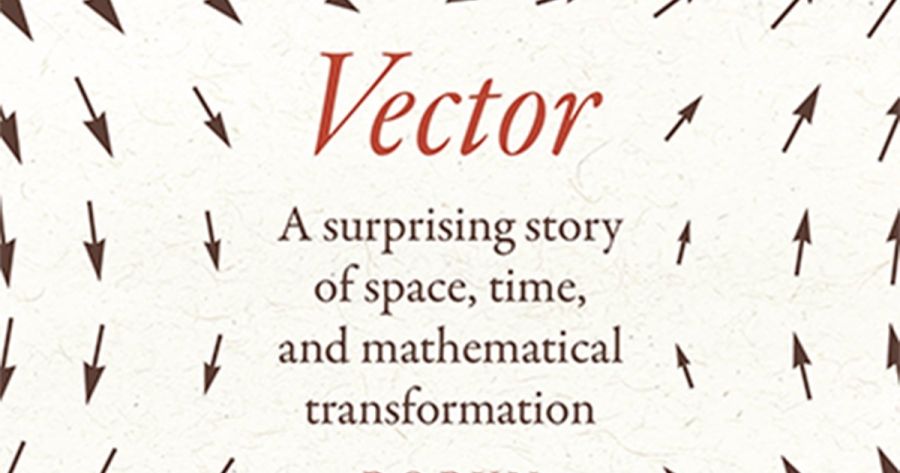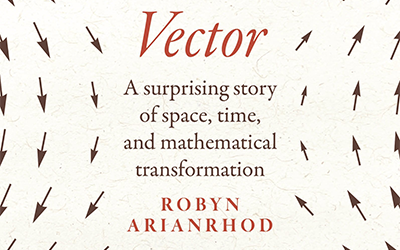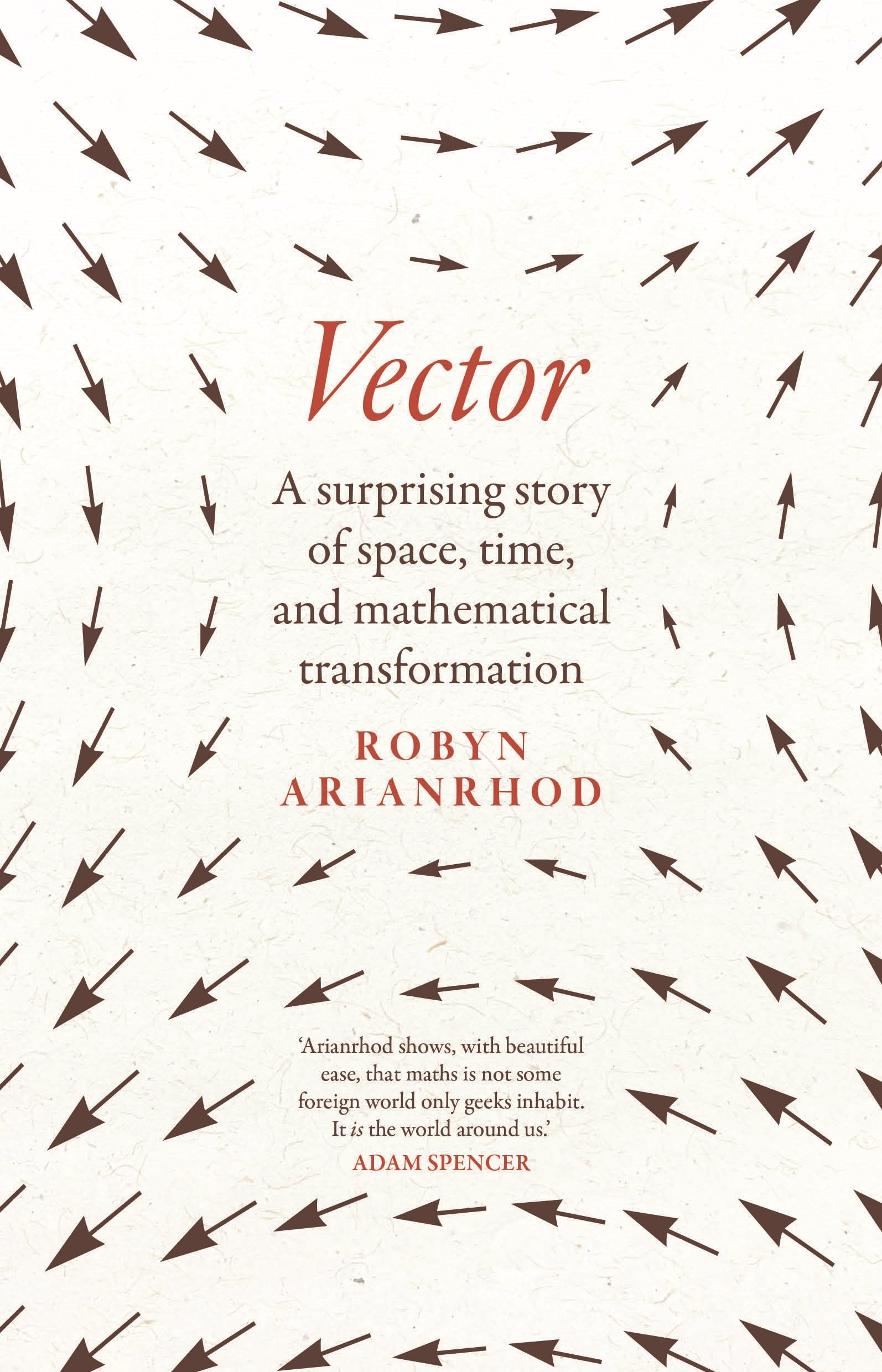
- Free Article: No
- Contents Category: Mathematics
- Review Article: Yes
- Article Title: i² = j² = k² = ijk = –1
- Article Subtitle: Vectors as an entire method of thinking
- Online Only: No
- Custom Highlight Text:
If you ever came across a vector in a high-school science class, it probably looked quite simple: a little arrow you might draw on a diagram to show the motion of a train or the forces on a swinging pendulum. An arrow pointing right would cancel an arrow pointing left, or → + ← = 0. Add together two arrows pointing in the same direction, you get one twice as long: →. A rightward arrow plus an upward one? You’ve got yourself a diagonal: → + ↑ = ↗.
- Featured Image (400px * 250px):

- Alt Tag (Featured Image): Michael Lucy reviews ‘Vector: A surprising story of space, time, and mathematical transformation’ by Robyn Arianrhod
- Book 1 Title: Vector
- Book 1 Subtitle: A surprising story of space, time, and mathematical transformation
- Book 1 Biblio: University of New South Wales Press, $44.99 pb, 472 pp
- Book 1 Cover Small (400 x 600):

- Book 1 Cover (800 x 1200):

Arianrhod starts her tale in ancient Mesopotamia, where numerical record-keeping and geometry developed alongside agriculture and urbanisation. Next we encounter Euclid and other ancient Greeks, the Persian ‘father of algebra’ al-Khwarizmi, Isaac Newton and the invention of calculus, and other milestones of mathematical history, before slowing down and zooming in as we reach the nineteenth century.
Here things kick off with a famous event that occurred in Dublin on 16 October 1843: Ireland’s astronomer royal, William Rowan Hamilton, had a flash of insight while walking to a meeting. He had been trying to describe mathematically the rotations of three-dimensional objects and finally understood how to do it using some items he called ‘quaternions’.
Overcome with the same impulse that sent Archimedes running naked through the streets of Syracuse shouting ‘Eureka!’, Hamilton took out his pocket knife and scratched a formula into the stone of the bridge he was crossing: i² = j² = k² = ijk = –1
What does this mean? Why was it so important? Well, as Arianrhod shows us, the letters represent different dimensions at right angles to one another, and the multiplications are a way of showing their relationships in number form. Quaternions were gradually streamlined into vectors, which do much the same job in a more intuitive way, and sent slow shockwaves through physics.
Vectors, Arianrhod explains, were not just a handy tool for calculations, but what Scottish physicist James Clerk Maxwell called an entire ‘method of thinking’ which helped him reformulate his revolutionary theory of electricity and magnetism. Maxwell’s discoveries later inspired the young Einstein to rework our understanding of space and time.
Arianrhod has an encyclopedic knowledge of the history of physics and mathematics, as well as a deep understanding of often very technical subject matter. The book has no shortage of mathematical detail for those who want it, much of it in the excellent and thorough endnotes. While the intricacies can be skimmed over without losing the narrative thread, less mathematically inclined readers may struggle with some sections.
Arianrhod’s deep research and attention to neglected figures in the history of science, many of them women, is refreshing. I was charmed to learn about the sixteenth-century Italian mathematician Nicolo Tartaglia, for instance, and his quest to understand the trajectory of cannonballs, and to read the enlightening section on Emmy Noether, the early twentieth-century German mathematician, whom Einstein and others called ‘the most important woman in the history of mathematics’. (If you’ll excuse a mathematical interlude, the result that physicists call Noether’s theorem is a cracker, proving that there is a fundamental link between symmetry and the idea that some things, like energy, are neither created nor destroyed.)
Parts of the story told in Vector will be familiar to readers of Arianrhod’s previous books, Seduced By Logic (2000), about the pioneering scientists Émilie du Châtelet and Mary Somerville, Einstein’s Heroes (2004), which covered the precursors of the theory of relativity, and Thomas Harriott (2019), a life of a little-remembered English Renaissance mathematician and astronomer.
Here, however, the events are all understood via the question of‘how to represent information’, and how the right representation can suddenly make clear unsuspected truths and connections. As Arianrhod writes, ‘describing physical reality mathematically creates a magnifying glass, revealing, through mathematical patterns, underlying physical attributes that had long lain hidden’.
Vector is a fascinating read in itself, but it also benefits from the context in which it arrives. In popular culture, the Promethean narrative of science often seems to have reached the ‘frequent eagle attacks’ part of the story. You come away from recent works like Benjamin Labatut’s book When We Cease to Understand The World and Christopher Nolan’s Oppenheimer feeling that the twentieth century’s surge of scientific and technical development was a spree whose bill is now coming due. Reading news reports about climate change or impending AI-driven doom does little to dispel the impression.
Vector is something of an antidote to, or at least respite from, this bleak picture. It focuses on the struggles of noble minds – sometimes tortured but mostly by the quest for knowledge – climbing to ever more rarefied levels of abstract understanding.
Early on, Arianrhod quotes Hamilton writing to a friend about his work on quaternions: ‘Do you not feel, as well as think, that we are on a right track, and shall be thanked hereafter?’
Perhaps works like Vector constitute a kind of thanks to Hamilton and all the others who found a path to the strange heights from which we now survey the world.


Comments powered by CComment